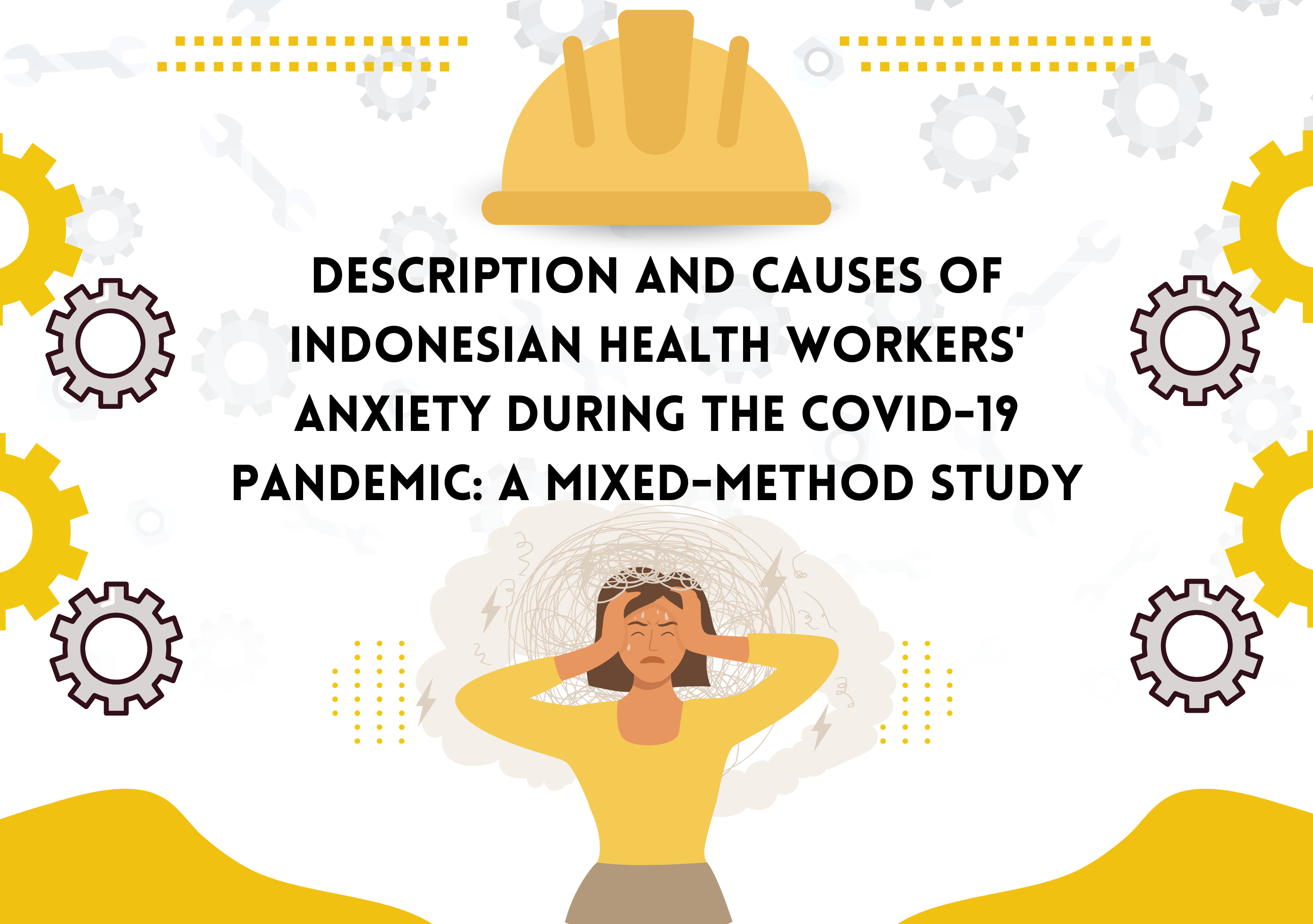Description and Causes of Indonesian Health Workers' Anxiety During the COVID-19 Pandemic: A Mixed-Method Study

Downloads
Introduction: The findings of a systematic review indicate that only a quantitative or qualitative approach was used in studies about the anxiety of health professionals during the COVID-19 pandemic. Research that aims to examine the level of anxiety experienced by Indonesian health workers during the COVID-19 pandemic, the signs and their causes will fill the scientific gap. Methods: A sequential explanatory design was used in this study. In the quantitative phase, the COVID-19 Anxiety Scale instrument was used to perform a survey on 731 healthcare workers, which was then descriptively examined. To further support its findings, 30 informants were involved to in-depth interviews, and qualitative content analysis was performed. Results: According to the poll, 15% of healthcare workers reported having high anxiety, 61% had moderate, 19% had low, and 5% had no anxiety at all. According to a qualitative content analysis, the signs of anxiety included overthinking, psychosomatic complaints, and worry about exposed to and transmit the virus at work. This is a result of managerial issues with managing pandemic, social changes, adjustments in interpersonal connection patterns, an unfriendly society, a large number of health workers who suffer with COVID-19, as well as personal variables. Conclusion: Preventive action for future health crisis situations is to improve systemic physical and non-physical preparedness in healthcare institutions. Psychosocial training programs such as cognitive coping and stress adaptation need to be carried out to improve the mental health condition of health workers so they don't ‘collapse' when dealing crisis situations.
Alzaid, E. et al. (2020) ‘Prevalence of COVID"‘19"‘Related Anxiety among Healthcare Workers: A Cross"‘Sectional Study', Journal of Family Medicine and Primary Care, 9(2), pp. 169–170.
Azwar, S. (2019) Penyusunan Skala Psikologi Edisi II. Yogyakarta: Pustaka Pelajar.
Cag, Yasemin et al. (2021) ‘Anxiety among Front-line Health-Care Workers Supporting Patients with COVID-19: A Global Survey', General Hospital Psychiatry, 68, pp. 90–96.
Chalhub, R. Á. et al. (2021) ‘Anxiety, Health-related Quality of Life, and Symptoms of Burnout in Frontline Physicians during the COVID-19 Pandemic', The Brazilian Journal of Infectious Diseases, 25(5), p. 101618.
Creswell, J. W. (2014) Research Design (Qualitative, Quantitative and Mixed Method Approaches) 4th edn. Los Angeles: SAGE Publication.
Dzulfaroh, A. N. (2020) Indonesia Terserah, Ekspresi Kekecewaan, dan Bentuk Protes kepada Pemerintah, Kompas.com.
Fahrudin, A. (2022) Perubahan Sosial Psikologi Di Masa Pandemi Covid-19. Bandung: PT Refika Aditama.
Gralinski, L. and Menachery, V. (2020) ‘Return of The Coronavirus: 2019-nCoV', Viruses, 12(2), p. 135.
Kibret, S. et al. (2020) ‘Prevalence of Anxiety towards COVID-19 and its Associated Factors among Healthcare Workers in a Hospital of Ethiopia', PLoS ONE, 15(12 December), pp. 1–10.
KPCPEN (2022) Data Sebaran COVID-19 di Indonesia, Komisi Penanganan COVID-19 dan Pemulihan Ekonomi Nasional.
Krishnamoorthy, Y. et al. (2020) ‘Prevalence of Psychological Morbidities among General Population, Healthcare Workers and COVID-19 Patients amidst the COVID-19 Pandemic: A Systematic Review and Meta-Analysis', Psychiatry Research, 293(May).
Landa-Blanco, M. et al. (2021) ‘Coronavirus Awareness, Confinement Stress, and Mental Health: Evidence from Honduras, Chile, Costa Rica, Mexico and Spain', Social Science & Medicine, 277, p. 113933.
Lau, S. S. S. et al. (2022) ‘COVID-19 Burnout Subject to the Dynamic Zero-COVID Policy in Hong Kong: Development and Psychometric Evaluation of the COVID-19 Burnout Frequency Scale', Sustainability, 14(14), pp. 1–13.
Ma, Y., Rosenheck, R. and He, H. (2020) ‘Psychological stress among health care professionals during the 2019 novel coronavirus disease Outbreak: Cases from online consulting customers', Intensive and Critical Care Nursing, 61, 102905.
Mahendradhata, Y. et al. (2021) ‘The Capacity of the Indonesian Healthcare System to Respond to COVID-19', Frontiers in Public Health, 9(July), pp. 1–9.
Al Maqbali, M., Al Sinani, M. and Al-Lenjawi, B. (2021) ‘Prevalence of Stress, Depression, Anxiety and Sleep Disturbance among Nurses during the COVID-19 Pandemic: A Systematic Review and Meta-Analysis', Journal of Psychosomatic Research, 141(February), pp.1-18 .
Marvaldi, M. et al. (2021) ‘Anxiety, Depression, Trauma-related, and Sleep Disorders among Healthcare Workers during the COVID-19 Pandemic: A Systematic Review and Meta-Analysis', Neuroscience and Biobehavioral Reviews, 126(December 2020), pp. 252–264.
Nguyen, J. et al. (2021) ‘Impacts and Challenges of the COVID-19 Pandemic on Emergency Medicine Physicians in the United States', American Journal of Emergency Medicine, 48, pp. 38–47.
Nurrachmawati, A. (2018) Pola dan Dinamika Pengambilan Keputusan Terkait Pemilihan Tempat dan Penolong Persalinan. Dissertation. Yogyakarta: Universitas Gadjah Mada.
Pappa, S. et al. (2020) ‘Prevalence of Depression, Anxiety, and Insomnia among Healthcare Workers during the COVID-19 Pandemic: A Systematic Review and Meta-Analysis', Brain, Behavior, and Immunity, 88(May), pp. 901–907.
Phuspa, S. M. (2023) Pengembangan Instrumen Burnout dalam Situasi Pandemi COVID-19 pada Tenaga Kesehatan. Dissertation. Yogyakarta: Universitas Gadjah Mada.
Rosyanti, L. and Hadi, I. (2020) ‘Dampak Psikologis dalam Memberikan Perawatan dan Layanan Kesehatan Pasien COVID-19 pada Tenaga Profesional Kesehatan', HIJP : Health Information Jurnal Penelitian 12(1), pp. 107-130.
Saeedi, M., Yazdi, S. and Bahador, R. C. (2022) ‘Predictors of COVID-19-Related Health Anxiety among Health Care Workers: A Cross-Sectional Study', BMC Psychology, 10(1), pp. 1–7.
Sakr, C. J. et al. (2022) ‘Anxiety Among Healthcare Workers During COVID-19 Pandemic in Lebanon: The Importance of the Work Environment and Personal Resilience', Psychology Research and Behavior Management, 15(April), pp. 811–821.
Saldana, J. (2017) The Coding Manual for Qualitative Researchers (3rd edition), Qualitative Research in Organizations and Management: An International Journal. Los Angeles: SAGE Publications.
Sheraton, M. et al. (2020) ‘Psychological Effects of the COVID 19 Pandemic on Healthcare Workers Globally: A Systematic Review', Psychiatry Research, 292(July).
da Silva, F. C. T. and Neto, M. L. R. (2021) ‘Psychological Effects Caused by the COVID-19 Pandemic in Health Professionals: A Systematic Review with Meta-Analysis', Progress in Neuro-Psychopharmacology and Biological Psychiatry, 104(June 2020), pp. 1-7.
Silva, W. A. D., de Sampaio Brito, T. R. and Pereira, C. R. (2022) ‘COVID-19 Anxiety Scale (CAS): Development and Psychometric Properties', Current Psychology, 41(8), pp. 5693–5702.
Sugiyono (2013) Metode Penelitian Kombinasi (Mixed Method). Bandung: Alfabeta.
Thatrimontrichai, A., Weber, D. J. and Apisarnthanarak, A. (2021) ‘Mental Health among Healthcare Personnel during COVID-19 in Asia: A Systematic Review', Journal of the Formosan Medical Association, 120(6), pp. 1296–1304.
WHO (2022) WHO Coronavirus (COVID-19) Dashboard.
Yassin, A. et al. (2022) ‘Prevalence Estimates and Risk Factors of Anxiety among Healthcare Workers in Jordan over One Year of the COVID-19 Pandemic: A Cross-Sectional Study', International Journal of Environmental Research and Public Health, 19(5), pp. 1–20.
Yıldırım, M. and Solmaz, F. (2020) ‘COVID-19 Burnout, COVID-19 Stress and Resilience: Initial Psychometric Properties of COVID-19 Burnout Scale', Death Studies, 46(3), pp.524-532.

This work is licensed under a Creative Commons Attribution-NonCommercial-ShareAlike 4.0 International License.

In order to be accepted and published by The Indonesian Journal of Occupational Safety and Health, Author(s) who submit an article should complete all the review process. The copyright of received articles assigned to the The Indonesian Journal of Occupational Safety and Health and Department of Safety and Health, Universitas Airlangga as publishers of the journal. The intended copyright includes the rights to publish articles in various forms (including reprints).
The Editorial Team of The Indonesian Journal Of Occupational Safety and Health and Department of Safety and Health strive to ensure that no errors occur in the articles that have been published, both data errors and statements in the article.
Users of this website will be licensed to use materials from this website following the Creative Commons Attribution-NonCommercial-ShareAlike 4.0 International License. No fees charged. Please use the materials accordingly.
------------------------------------------------------------------------------------------------------------------------------------------------------------------------------------------
Attribution ” You must give appropriate credit, provide a link to the license, and indicate if changes were made. You may do so in any reasonable manner, but not in any way that suggests the licensor endorses you or your use.
NonCommercial ” You may not use the material for commercial purposes.
ShareAlike ” If you remix, transform, or build upon the material, you must distribute your contributions under the same license as the original.







 How to Submit Articles in OJS
How to Submit Articles in OJS

























